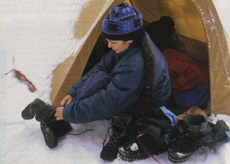« Atlas 12 Series Snow Shoes | Main | RedFeather Stride Snow Shoes For Women »
Cold Feet Relief – How To Treat Trench Foot and Chilblains
By Editor | January 14, 2009
 You don’t need frost to suffer cold injuries. Prolonged exposure to dampness in temperatures as high as 55°F can lead to several debilitating skin conditions.
You don’t need frost to suffer cold injuries. Prolonged exposure to dampness in temperatures as high as 55°F can lead to several debilitating skin conditions.
Immersion foot-also known as trench foot due to its prevalence in World War I-is a serious ailment that can begin after only 12 hours in soggy, chilly conditions. Impaired blood flow to the feet results in swelling, then pain as nerves and muscles are damaged.
When you rewarm affected feet, the skin turns red or blue, and blisters may form and get infected, eventually leading to gangrene.
Like trench foot, chilblains start with the constriction of blood vessels, which cuts off oxygen and nutrients to the skin. The first signs are small, red, itchy patches on the hands, feet, nose, or ears. In severe cases, victims develop dark-blue sores that become shiny and swell painfully. Follow these simple tips to avoid and treat both conditions.
PREVENTION
» Wear waterproof boots and gaiters, and regularly replace wet socks with dry ones. » Always remove damp or wet socks before going to bed. Dry them inside your clothes against your skin during the day, or by placing them inside your sleeping bag at night.
» Loosen bootlaces and avoid too-bulky socks; tight footwear can restrict blood flow. Change into down or synthetic booties when you arrive at camp.
» Wear liner socks and gloves to create warm air pockets between outer garments and your skin.
» In winter, get an early-morning start to hike atop frozen snow instead of slogging through wet slush.
TREATMENT
» Test your skin’s capillary-refill time by pressing a suspected cold injury firmly with a finger for 5 seconds. If it takes longer than 2 seconds for the skin to recover its pink color, your blood flow is restricted.
» Clean and dry the affected area, then put on dry socks or gloves.
» Build a fire to warm up and dry out boots and socks.
» Gradually rewarm affected areas by placing them against someone’s belly or in a sleeping bag. Elevate the feet to reduce swelling, and take ibuprofen for pain. Never warm numb or frozen skin with high heat. » In serious cases, pain and blisters may prevent walking, but early intervention and dry clothing should reverse the injury.
Bookmark at:StumbleUpon | Digg | Del.icio.us | Dzone | Newsvine | Spurl | Simpy | Furl | Reddit | Yahoo! MyWeb
Topics: Articles, Outdoor First Aid, Snow Sports | Comments Off on Cold Feet Relief – How To Treat Trench Foot and Chilblains



